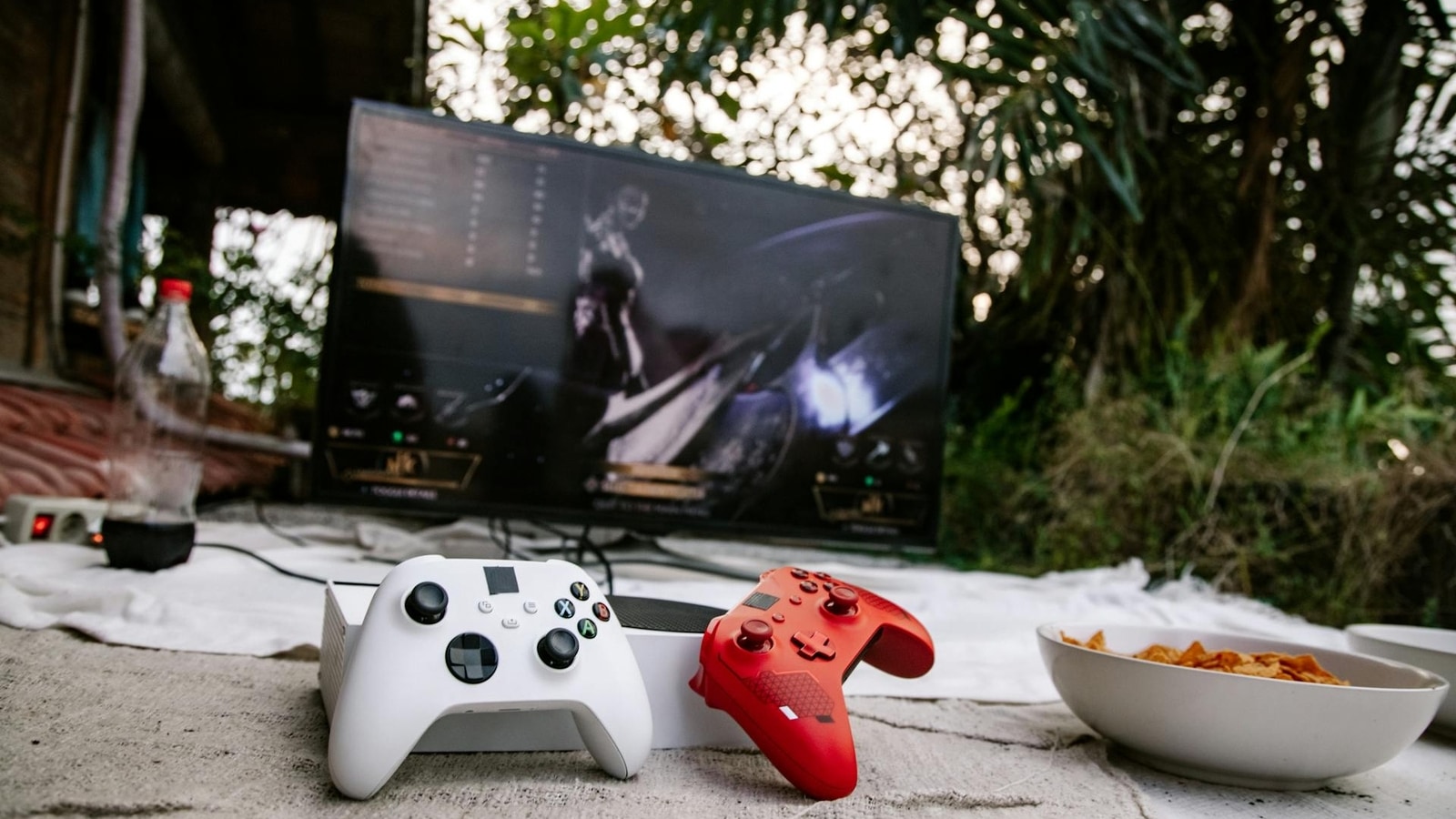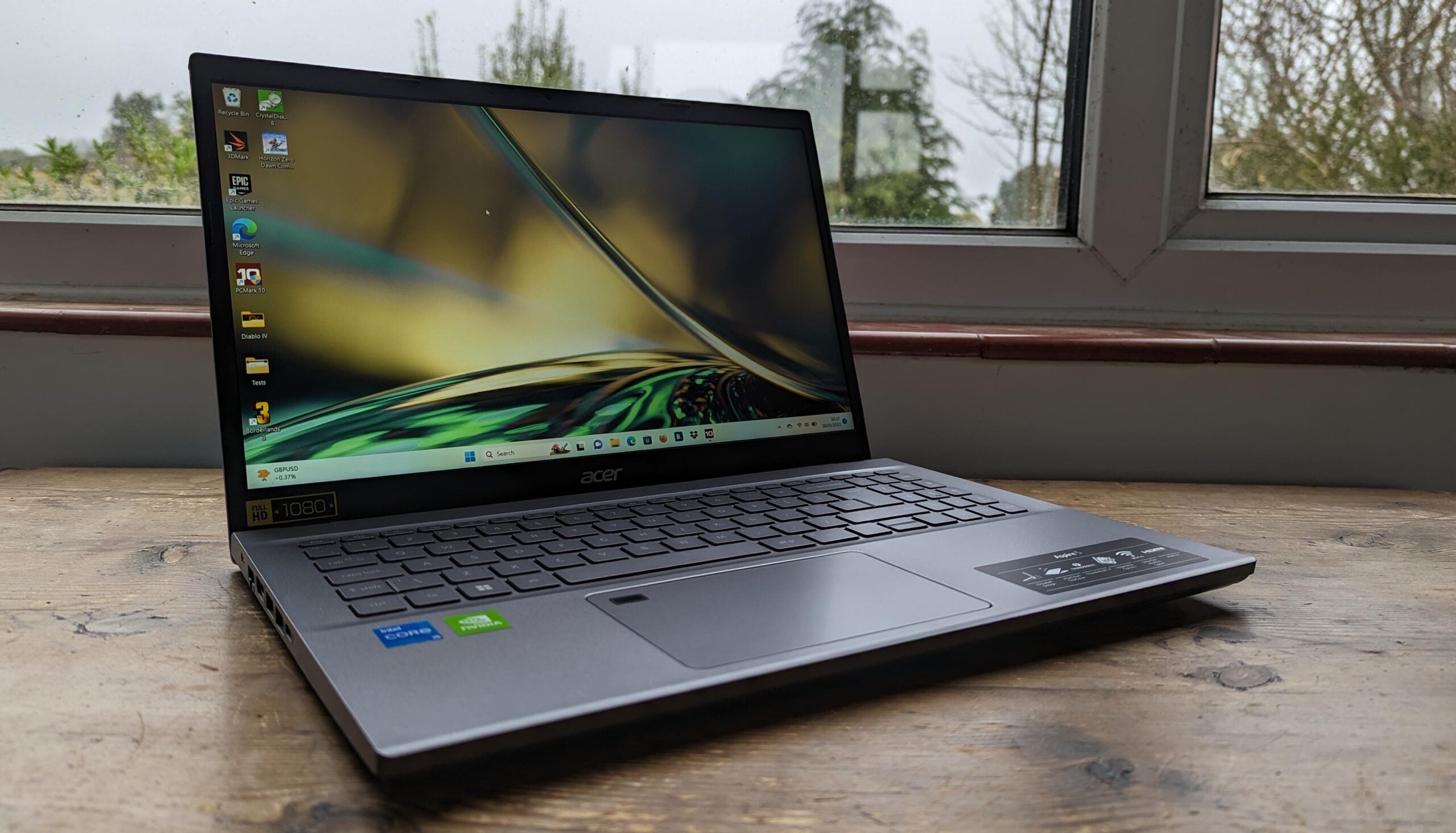Verdict
The Acer Aspire 5 is a decent laptop for its price, with satisfactory specs and solid build quality. But, it’s let down by the battery life and lacklustre screen. The competition provides more well-rounded buys.
Pros
- Good CPU and plenty of RAM
- Solid build quality
- NVIDIA GPU and Thunderbolt 4
Cons
- Dim 15.6-inch screen
- Unimpressive battery life
- Bouncy keyboard and muddy sound
Availability
- UKRRP: £799
- USARRP: $899
- Europeunavailable
- CanadaRRP: CA$1243
- Australiaunavailable
Introduction
Does anyone aspire to own one of Acer’s budget or mid-range consumer laptops? Maybe not in the sense that we’d aspire to a MacBook Pro or an Asus ROG Strix Scar, but an Acer Aspire 5 is still the kind of laptop that a lot of us end up buying.
That isn’t a criticism. There’s a need for good, affordable laptops with decent specs and build quality. Acer, HP, Dell and Lenovo all address this with their Aspire, Pavilion, Inspiron and IdeaPad lines.
Creating a well-rounded yet affordable laptop is always a balancing act, and building something that stands out is a real feat. The Aspire 5 doesn’t do a bad job, but it falls down in some key areas and the cost-trimming shows. It’s good value when taken as a package, even if it’s not the best or most exciting device you could get for the money.
Design and Keyboard
- Aluminium lid meets plastic body
- Good connectivity with Thunderbolt 4
- Keyboard feels cramped on the left with a bouncy deck
The Aspire 5 arguably looks its best when the lid is closed, allowing you to enjoy the aluminium cover – available in a range of colours depending on the size and spec. Our 15.6-inch, Core i5 review sample arrived in a fetching light blue. Open up the clamshell and you’re looking at a more mundane design, with a two-part plastic base and a chunky textured frame around the screen. It’s still a good-looking design, and Acer has minimised the bulk by giving the Aspire 5 a wedge-shaped profile. It’s only 18mm thick with a 363 by 238mm desktop footprint.
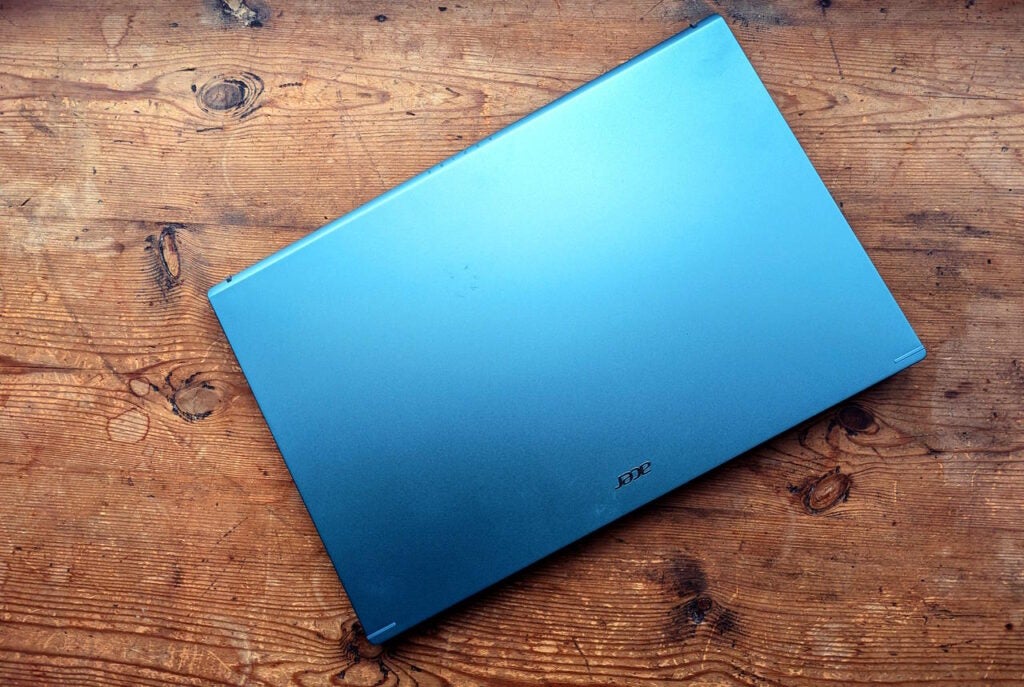
The build quality is decent, too. There’s some flex in the lid, but nothing worrying. The base of the unit doesn’t have any rough edges and feels solid and robust. The vents are mostly on the base, with an additional outlet near the right-hand hinge, and there’s little fan noise while you’re running everyday apps. You won’t mistake the Aspire 5 for a premium laptop, but there’s nothing horribly budget to be found here.
Acer has upgraded the Aspire 5’s connectivity, giving it a single USB Type-C port with Thunderbolt 4 support. Beyond that, you get an RJ-45 Gigabit Ethernet port, three USB 3.2 Gen 1 Type-A ports, an HDMI output and a 3.5mm audio socket. My only serious grumble is that Acer is still sticking with an old-school, slimline barrel connector for power, and, while the plug itself looks well reinforced, I always worry about how long the socket will last in everyday use.
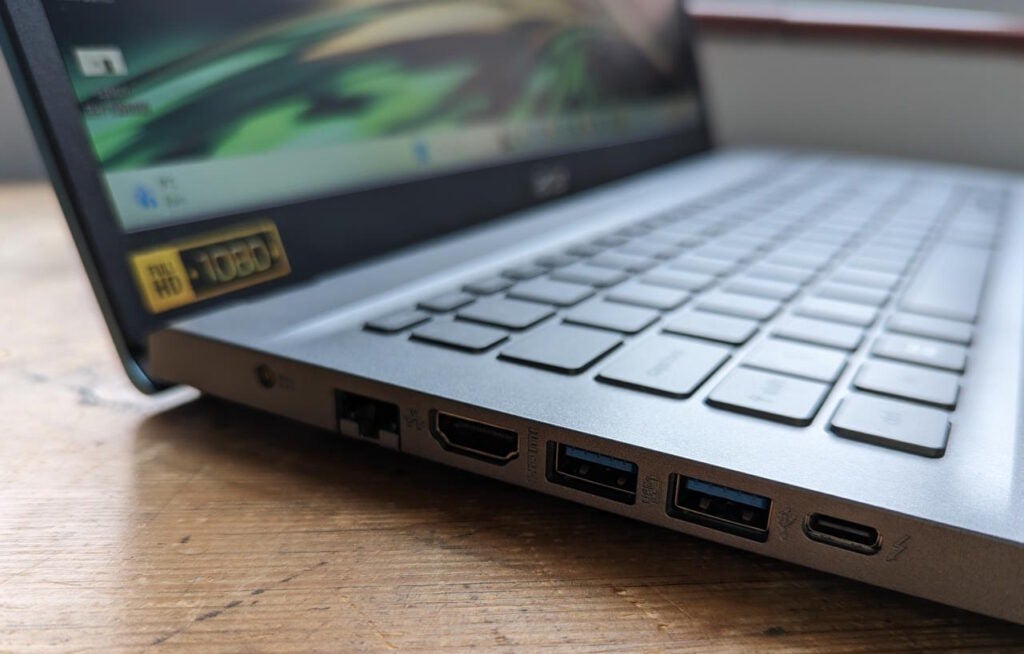
We’re beginning to see more budget and mid-range laptops with Wi-Fi 6E, but the Aspire 5 isn’t one of them. It’s just straight Wi-Fi 6 here.
The keyboard is one area where Acer has got it wrong. The keys themselves aren’t bad, despite a slightly spongey action, but the layout is oddly cramped on the left-hand side. Meanwhile, Acer has shoehorned in a slimmed-down numeric pad on the right. What’s more, the deck of the keyboard flexes slightly as you type, giving it an odd bouncy feel.
Thankfully, the touchpad is smooth and glassy-feeling, not to mention accurate in its tracking. The click-down mechanism works nearly all the way up. It’s just a slight shame that Acer has stuck the fingerprint sensor in the top-left corner, where it occasionally gets in the way.
Display and Sound
- Low brightness levels and mediocre contrast
- Only 66% sRGB gamut coverage
- Audio is thin with a congested mid-range
There’s no getting around it: the Aspire 5’s screen is dull. Colours look flat, there’s not much contrast and clarity isn’t all it could be. It’s fine for office apps, browsing and email but try watching Netflix and you’ll soon be wishing that you were watching it on something else.
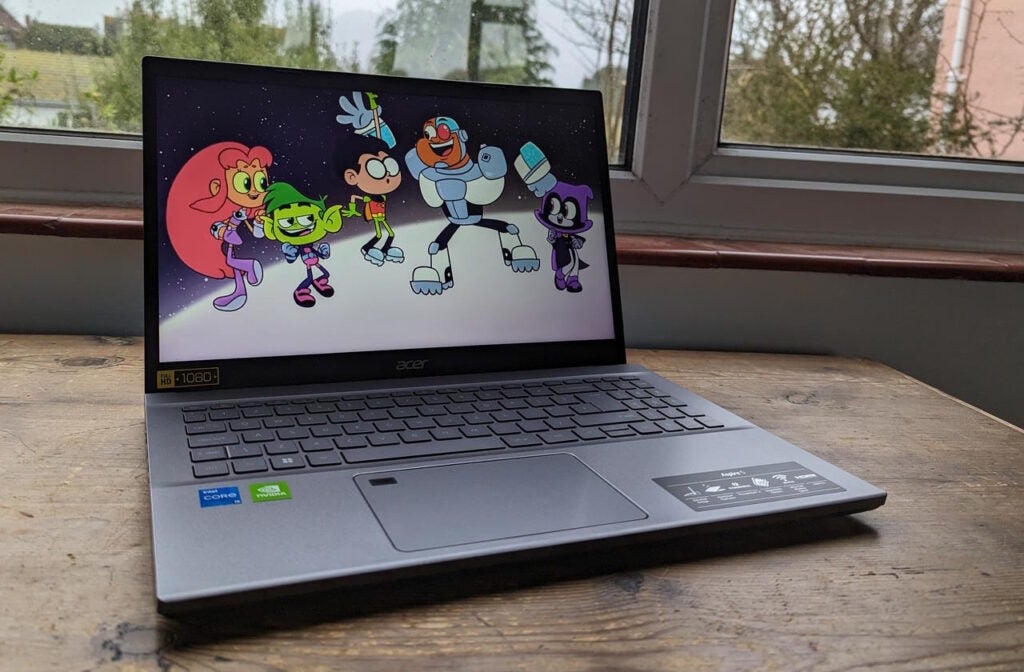
I don’t necessarily expect QHD resolutions or 100% sRGB coverage at this price level, but the Aspire 5’s 1080p display only covers 66.2% of the colour gamut and 46.9% of DCI-P3. The maximum brightness I measured was a woeful 232 nits. Black levels are a more reasonable 0.22nits but that still leaves the contrast at just 1061.5:1. The overall effect is deeply underwhelming. If you like your colours bright and punchy, you’re not going to get that here.
Much the same goes for the audio. It goes reasonably loud, but the presentation is slightly muddy and the tone is thin. Keep some headphones handy.
Performance
- Good speeds in office and creative applications
- MX550 GPU can’t handle more demanding games
- Nippy SSD doesn’t let the spec down
The Aspire 5 comes in Intel and AMD variants, with Ryzen 5, Ryzen 7, Core i5 and i7 versions and 8 or 16GB of DDR4 RAM. Our model arrived with a Core i5-1235U and 16GB of RAM, plus a GeForce MX550 handling graphics duties.
The i5-1235U focuses on efficiency over raw performance, with two Performance cores and eight Efficient cores for a total of 12 threads. Clock speeds max out at 4.4GHz for the P cores and 3.3GHz for the E cores. The benchmark scores are solid but nothing much to write home about. Everything felt slick and lag-free during everyday use and you could run demanding creative apps without any major problems. Combine the i5-1235U and 16GB of RAM, and this isn’t a slow machine.
The MX550 is a step up from integrated graphics for gaming, but you shouldn’t set your expectations too high. Borderlands 3 was stuck at 15fps on Ultra settings at the default fan profile and Horizon Zero Dawn refused to run. On Borderlands 3, switching to medium only took us to just 32fps with obvious hitches every few seconds. However, switching the fan profile to high – all it takes is an Fn+F key shortcut – was enough to take us up to 24.42fps in Ultra and 48fps in Medium, making the game playable. More advanced titles, and anything requiring more than 2GB of RAM on the GPU side, will be off the menu with the Acer Aspire 5.
One mistake Acer hasn’t made is fitting a slow SSD. There are sequential read speeds of 3751.5MB/sec and write speeds of 3333MB/sec. It’s a reasonably fast 500GB SSD that’s more than adequate for everyday computing, or even light creative work.
Battery Life
- Six hours and 20 minutes of battery life
- Around six hours of video playback at full brightness
Battery life is mildly disappointing for a Core i5 laptop with a relatively low-powered GPU. We could only get six hours and 20 minutes from the Acer Aspire 5 in PC Mark 10’s Modern Office battery benchmark, which is closer to the level I’d expect from a gaming laptop than one with a more modest spec.
It’s not going to get you through a busy day, though lighter users might be able to get away with a daily charge. Turn the brightness up to full and you’re looking at around six hours of video playback. I’d have hoped for more.
Latest deals
Should you buy it?
You value function over form
You’re getting a Core i5 CPU and 16GB of RAM for sensible money, along with a few useful extras like Thunderbolt 4 and a discrete GPU. It’s decent value for money.
You want a nice screen and long battery life
The screen is dim with lacklustre colour reproduction and battery life is average at best. This looks and feels like a laptop that’s been built to a mid-range budget.
Final Thoughts
Put the disappointing display aside, and the Acer Aspire 5 is pretty much what you’d expect at this price point: a solid, well-built laptop with a good core spec at a fair price. Acer’s problem is that we’re beginning to expect more. Devices like the Huawei MateBook D16 are arriving with better screens and more appealing designs, and Acer’s own Swift 3 and Swift X lines are stronger on both counts.
Meanwhile, spending a little more will get you a more vibrant, higher-resolution display or more performance. This isn’t a bad laptop by any means, but shouldn’t you aspire to something more?
How we test
Every laptop we review goes through a series of uniform checks designed to gauge key things including build quality, performance, screen quality and battery life.
These include formal synthetic benchmarks and scripted tests, plus a series of real world checks, such as how well it runs popular apps.
FAQs
This model of the Aspire 5 was released last year, but the Aspire range has been around since the 20th century.
Both of these manufacturers make a lot of laptops but, in our experience, HP generally prioritises higher quality design while Acer focuses on value for money.
Trusted Reviews test data
PCMark 10
Geekbench 5 single core
Geekbench 5 multi core
3DMark Time Spy
CrystalDiskMark Read speed
CrystalMarkDisk Write Speed
Brightness
Black level
Contrast
White Visual Colour Temperature
sRGB
Adobe RGB
DCI-P3
PCMark Battery (office)
Battery Life
Borderlands 3 frame rate (Full HD)
Horizon Zero Dawn frame rate (Quad HD)
Horizon Zero Dawn frame rate (Full HD)
UK RRP
USA RRP
EU RRP
CA RRP
AUD RRP
CPU
Manufacturer
Quiet Mark Accredited
Screen Size
Storage Capacity
Front Camera
Battery
Battery Hours
Size (Dimensions)
Weight
Operating System
Release Date
First Reviewed Date
Model Number
Model Variants
Resolution
HDR
Refresh Rate
Ports
GPU
RAM
Connectivity
Colours
Display Technology
Screen Technology
Touch Screen
Convertible?
Verdict
The Acer Aspire 5 is a decent laptop for its price, with satisfactory specs and solid build quality. But, it’s let down by the battery life and lacklustre screen. The competition provides more well-rounded buys.
Pros
- Good CPU and plenty of RAM
- Solid build quality
- NVIDIA GPU and Thunderbolt 4
Cons
- Dim 15.6-inch screen
- Unimpressive battery life
- Bouncy keyboard and muddy sound
Availability
- UKRRP: £799
- USARRP: $899
- Europeunavailable
- CanadaRRP: CA$1243
- Australiaunavailable
Introduction
Does anyone aspire to own one of Acer’s budget or mid-range consumer laptops? Maybe not in the sense that we’d aspire to a MacBook Pro or an Asus ROG Strix Scar, but an Acer Aspire 5 is still the kind of laptop that a lot of us end up buying.
That isn’t a criticism. There’s a need for good, affordable laptops with decent specs and build quality. Acer, HP, Dell and Lenovo all address this with their Aspire, Pavilion, Inspiron and IdeaPad lines.
Creating a well-rounded yet affordable laptop is always a balancing act, and building something that stands out is a real feat. The Aspire 5 doesn’t do a bad job, but it falls down in some key areas and the cost-trimming shows. It’s good value when taken as a package, even if it’s not the best or most exciting device you could get for the money.
Design and Keyboard
- Aluminium lid meets plastic body
- Good connectivity with Thunderbolt 4
- Keyboard feels cramped on the left with a bouncy deck
The Aspire 5 arguably looks its best when the lid is closed, allowing you to enjoy the aluminium cover – available in a range of colours depending on the size and spec. Our 15.6-inch, Core i5 review sample arrived in a fetching light blue. Open up the clamshell and you’re looking at a more mundane design, with a two-part plastic base and a chunky textured frame around the screen. It’s still a good-looking design, and Acer has minimised the bulk by giving the Aspire 5 a wedge-shaped profile. It’s only 18mm thick with a 363 by 238mm desktop footprint.

The build quality is decent, too. There’s some flex in the lid, but nothing worrying. The base of the unit doesn’t have any rough edges and feels solid and robust. The vents are mostly on the base, with an additional outlet near the right-hand hinge, and there’s little fan noise while you’re running everyday apps. You won’t mistake the Aspire 5 for a premium laptop, but there’s nothing horribly budget to be found here.
Acer has upgraded the Aspire 5’s connectivity, giving it a single USB Type-C port with Thunderbolt 4 support. Beyond that, you get an RJ-45 Gigabit Ethernet port, three USB 3.2 Gen 1 Type-A ports, an HDMI output and a 3.5mm audio socket. My only serious grumble is that Acer is still sticking with an old-school, slimline barrel connector for power, and, while the plug itself looks well reinforced, I always worry about how long the socket will last in everyday use.

We’re beginning to see more budget and mid-range laptops with Wi-Fi 6E, but the Aspire 5 isn’t one of them. It’s just straight Wi-Fi 6 here.
The keyboard is one area where Acer has got it wrong. The keys themselves aren’t bad, despite a slightly spongey action, but the layout is oddly cramped on the left-hand side. Meanwhile, Acer has shoehorned in a slimmed-down numeric pad on the right. What’s more, the deck of the keyboard flexes slightly as you type, giving it an odd bouncy feel.
Thankfully, the touchpad is smooth and glassy-feeling, not to mention accurate in its tracking. The click-down mechanism works nearly all the way up. It’s just a slight shame that Acer has stuck the fingerprint sensor in the top-left corner, where it occasionally gets in the way.
Display and Sound
- Low brightness levels and mediocre contrast
- Only 66% sRGB gamut coverage
- Audio is thin with a congested mid-range
There’s no getting around it: the Aspire 5’s screen is dull. Colours look flat, there’s not much contrast and clarity isn’t all it could be. It’s fine for office apps, browsing and email but try watching Netflix and you’ll soon be wishing that you were watching it on something else.

I don’t necessarily expect QHD resolutions or 100% sRGB coverage at this price level, but the Aspire 5’s 1080p display only covers 66.2% of the colour gamut and 46.9% of DCI-P3. The maximum brightness I measured was a woeful 232 nits. Black levels are a more reasonable 0.22nits but that still leaves the contrast at just 1061.5:1. The overall effect is deeply underwhelming. If you like your colours bright and punchy, you’re not going to get that here.
Much the same goes for the audio. It goes reasonably loud, but the presentation is slightly muddy and the tone is thin. Keep some headphones handy.
Performance
- Good speeds in office and creative applications
- MX550 GPU can’t handle more demanding games
- Nippy SSD doesn’t let the spec down
The Aspire 5 comes in Intel and AMD variants, with Ryzen 5, Ryzen 7, Core i5 and i7 versions and 8 or 16GB of DDR4 RAM. Our model arrived with a Core i5-1235U and 16GB of RAM, plus a GeForce MX550 handling graphics duties.
The i5-1235U focuses on efficiency over raw performance, with two Performance cores and eight Efficient cores for a total of 12 threads. Clock speeds max out at 4.4GHz for the P cores and 3.3GHz for the E cores. The benchmark scores are solid but nothing much to write home about. Everything felt slick and lag-free during everyday use and you could run demanding creative apps without any major problems. Combine the i5-1235U and 16GB of RAM, and this isn’t a slow machine.
The MX550 is a step up from integrated graphics for gaming, but you shouldn’t set your expectations too high. Borderlands 3 was stuck at 15fps on Ultra settings at the default fan profile and Horizon Zero Dawn refused to run. On Borderlands 3, switching to medium only took us to just 32fps with obvious hitches every few seconds. However, switching the fan profile to high – all it takes is an Fn+F key shortcut – was enough to take us up to 24.42fps in Ultra and 48fps in Medium, making the game playable. More advanced titles, and anything requiring more than 2GB of RAM on the GPU side, will be off the menu with the Acer Aspire 5.
One mistake Acer hasn’t made is fitting a slow SSD. There are sequential read speeds of 3751.5MB/sec and write speeds of 3333MB/sec. It’s a reasonably fast 500GB SSD that’s more than adequate for everyday computing, or even light creative work.
Battery Life
- Six hours and 20 minutes of battery life
- Around six hours of video playback at full brightness
Battery life is mildly disappointing for a Core i5 laptop with a relatively low-powered GPU. We could only get six hours and 20 minutes from the Acer Aspire 5 in PC Mark 10’s Modern Office battery benchmark, which is closer to the level I’d expect from a gaming laptop than one with a more modest spec.
It’s not going to get you through a busy day, though lighter users might be able to get away with a daily charge. Turn the brightness up to full and you’re looking at around six hours of video playback. I’d have hoped for more.
Latest deals
Should you buy it?
You value function over form
You’re getting a Core i5 CPU and 16GB of RAM for sensible money, along with a few useful extras like Thunderbolt 4 and a discrete GPU. It’s decent value for money.
You want a nice screen and long battery life
The screen is dim with lacklustre colour reproduction and battery life is average at best. This looks and feels like a laptop that’s been built to a mid-range budget.
Final Thoughts
Put the disappointing display aside, and the Acer Aspire 5 is pretty much what you’d expect at this price point: a solid, well-built laptop with a good core spec at a fair price. Acer’s problem is that we’re beginning to expect more. Devices like the Huawei MateBook D16 are arriving with better screens and more appealing designs, and Acer’s own Swift 3 and Swift X lines are stronger on both counts.
Meanwhile, spending a little more will get you a more vibrant, higher-resolution display or more performance. This isn’t a bad laptop by any means, but shouldn’t you aspire to something more?
How we test
Every laptop we review goes through a series of uniform checks designed to gauge key things including build quality, performance, screen quality and battery life.
These include formal synthetic benchmarks and scripted tests, plus a series of real world checks, such as how well it runs popular apps.
FAQs
This model of the Aspire 5 was released last year, but the Aspire range has been around since the 20th century.
Both of these manufacturers make a lot of laptops but, in our experience, HP generally prioritises higher quality design while Acer focuses on value for money.
Trusted Reviews test data
PCMark 10
Geekbench 5 single core
Geekbench 5 multi core
3DMark Time Spy
CrystalDiskMark Read speed
CrystalMarkDisk Write Speed
Brightness
Black level
Contrast
White Visual Colour Temperature
sRGB
Adobe RGB
DCI-P3
PCMark Battery (office)
Battery Life
Borderlands 3 frame rate (Full HD)
Horizon Zero Dawn frame rate (Quad HD)
Horizon Zero Dawn frame rate (Full HD)
UK RRP
USA RRP
EU RRP
CA RRP
AUD RRP
CPU
Manufacturer
Quiet Mark Accredited
Screen Size
Storage Capacity
Front Camera
Battery
Battery Hours
Size (Dimensions)
Weight
Operating System
Release Date
First Reviewed Date
Model Number
Model Variants
Resolution
HDR
Refresh Rate
Ports
GPU
RAM
Connectivity
Colours
Display Technology
Screen Technology
Touch Screen
Convertible?








